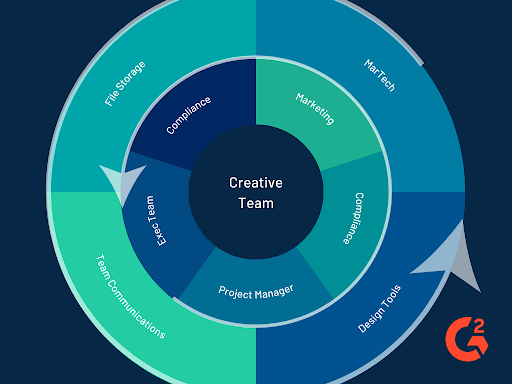In the past few years, there’s been a noticeable rise in in-house creative teams, driven by the need to create high-quality, engaging content faster than ever. Businesses are not just competing with other brands for attention. They now have to compete with individuals creating relatable, authentic, and relevant content while maintaining brand compliance.
In this new era of social media, visual content, more specifically video content, is taking over the internet. Individual content creators are proving to be a challenge to a company’s social media marketing strategy. In the face of various engaging content put out by them, a company’s branded campaign can come off as forced and inauthentic. With the proliferation of content in the past few years, customers have become more mindful of the content they’re looking at and what they deem trustworthy. Faced with this unique challenge, could creative collaboration be the answer that companies want?
| Read more: Content Creation: Its Importance and a Guide to Get You Started → |
Making branded content authentic with creative collaboration
Creative collaboration is a new approach to creative workflows. It’s what happens when teams work together to create content from ideation to publishing. With the shift to remote work, traditional collaboration practices must be reenvisioned. Extensive projects or teams with more moving pieces can make it challenging to collaborate online.
Creative projects entail a group of people generating content ideas, designers creating the content, managers and other department heads signing off on the content, project managers moving everything along, and a lot of back and forth. All this is happening across different locations and time zones and is being managed from various devices.
The flow chart below displays the complexity of the creative process by showing the different teams and tools involved.

What is Creative Collaboration?
Creative collaboration improves teams’ abilities to generate and execute new ideas by allowing individuals to have more transparency into the creative workflow and to communicate better with one another.
Several factors make for successful creative collaboration:
- Customized workflows: Every creative project is unique. The design phase timeline will differ. Some projects will have dozens of versions, while others will be finalized with minor edits. Larger campaigns need sign-off from multiple higher-ups, while a single social media post will not. Creative collaboration allows to forego rigidity in workflows, making space for realistic expectations and giving projects the time they need.
- Discussions: Teams need the means to communicate effectively at each step in the creative workflow process. Whether this means leaving comments directly on the content file, assigning colleagues specific editing tasks, or recording an audio clip to discuss their thoughts. The correct people need access to the content and many methods to provide and receive feedback.
-
Access to materials: Creative projects need collateral and information often stored in disparate locations. For example, a marketing campaign visual created in graphic design software will require images from a digital asset management system and brand collateral stored from a design systems tool. The project will need to be managed on project management software and then passed on to marketing tools to be published. Given the plethora of tools and assets involved in the creative process, it’s integral for individuals to access all of them easily.
Keeping your creative team more connected than ever
Until recently, businesses used separate tools to manage different aspects of the creative process. However, several software players in the market now combine the functionality of these disparate tools into one platform. Creative collaboration software combines the functionality of online proofing tools, project management software, and workflow management software. Creative collaboration platforms provide the ability to automate and customize different project workflows and set steps to trigger actions. They also allow teams to apply their brand standards to the creative workflow, ensuring accountability and brand consistency.
| Read more: The Art of Brand Storytelling → |
With one platform, creative teams can:
- Access the resources they need to create assets
- Request and receive feedback
- Loop in any stakeholders that need to sign off on the content
- Collaborate and make edits
- Have visibility over the entire workflow
Teams with fewer stakeholders and a smaller tech stack may not need a fully integrated platform like this, so they may opt to use a project or work management tool or a standalone online proofing tool.
Creative collaboration is the future
These improvements in technology to enhance digital collaboration are not unique to creative teams. Even as companies revoke remote work policies and people head back to the office, the way we work has permanently changed. Instead of walking over to someone’s desk, we message them. Instead of brainstorming on a whiteboard, we work off a digital board. So the software is changing as well. It’s still doing everything it’s meant for while making it easier and faster for people to do those things together digitally.
Edited by Shanti S Nair
¿Quieres aprender más sobre Software de diseño? Explora los productos de Diseño.

Priya Patel
Priya is a Senior Research Analyst at G2 focusing on content management and design software. Priya leverages her background in market research to build subject matter expertise in the software space. Before moving back to Chicago in 2018, Priya lived in New Zealand for several years, where she studied at the University of Auckland and worked in consulting. In her free time, Priya enjoys being creative, whether it’s painting, cooking, or dancing.
